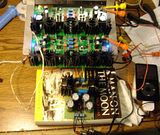amb
Member of the Trade: AMB Laboratories
- Joined
- Apr 1, 2004
- Posts
- 4,933
- Likes
- 41
Possédé, what you've linked to looks like an incandescent lamp, not LED. If so, its operating current may be highly variable depending on the filament temperature and is difficult to predict. You'd have to experiment to get an appropriate series resistance.
cfcubed, using 100pF would cut the amp's bandwidth severely. Why not just get the correct 33pF caps? I generally don't recommend putting in "temporary" substitute parts only to replace them later, because it would require desoldering and resoldering, and needlessly stressing the board pads.
cfcubed, using 100pF would cut the amp's bandwidth severely. Why not just get the correct 33pF caps? I generally don't recommend putting in "temporary" substitute parts only to replace them later, because it would require desoldering and resoldering, and needlessly stressing the board pads.


























